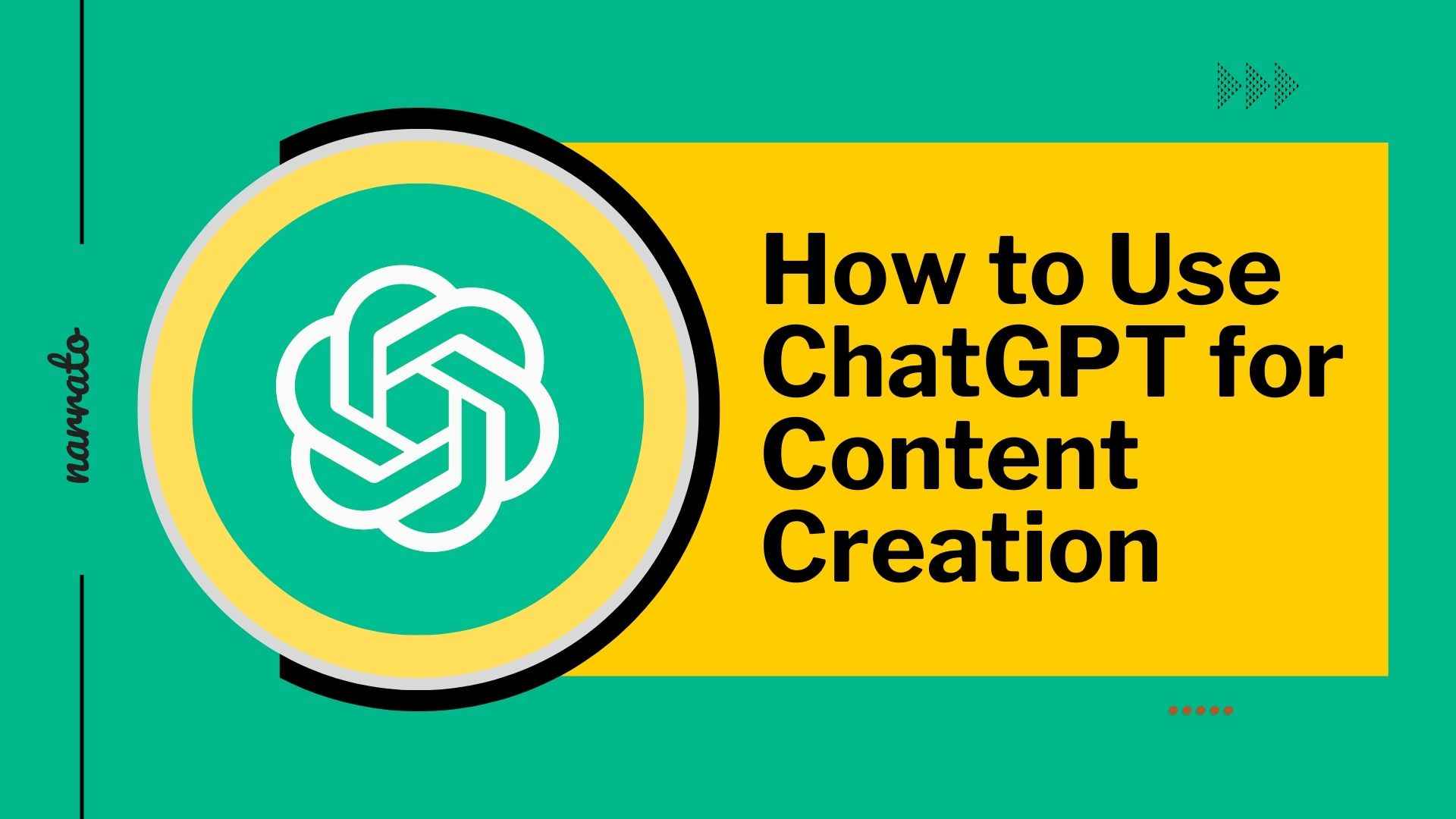Generative AI is making waves in the content marketing space. From AI writing tools to AI art, it is everywhere. But one tool that has been a real game-changer is ChatGPT. This AI answer engine developed by OpenAI works like an intelligent search engine that can give you the most comprehensive answer to your query. ChatGPT has immense use in many different areas, but for content creators, it can be an indispensable asset. If you are wondering how to use ChatGPT and AI content creation tools, this article will answer all your questions.
We will discuss what types of content you can create with ChatGPT, how to get appropriate outputs for these content types, and some handy tips and tricks to use ChatGPT more effectively in your content creation process.
TL;DR Here’s a quick video summarizing the article.
What types of content can you create with ChatGPT?
- Creating blog content with ChatGPT
- Creating social media content with ChatGPT
- Creating email content with ChatGPT
- Creating web copy with ChatGPT
- Creating SEO content with ChatGPT
- Creating content summaries with ChatGPT
- Creating video scripts and descriptions with ChatGPT
- Creating press releases with ChatGPT
- Collecting statistics and figures with ChatGPT
- Editing and content quality assessment with ChatGPT
- Translating content into different languages with ChatGPT
Tips and tricks for using ChatGPT effectively

Content creation with ChatGPT
We have already discussed what is ChatGPT and how it works in one of our previous articles. ChatGPT, like most other generative AI tools, is trained on natural language models. The GPT model or generative pre-trained transformer is trained to understand patterns in natural language and predict the words and sentences that should come next in a sequence. That is how it answers your queries.
To explain it in simple terms, ChatGPT generates content based on the prompts you give it. For example, if you ask, “Tell me about dogs,” you’ll get a general answer. But, if you specify, “Tell me about the temperament and care needs of Golden Retrievers,” you’ll receive a much richer and more targeted response. That means the content quality largely depends on the quality of your input. If you want to make your life simple, Narrato’s AI content assistant can be invaluable. It has more than 100 AI templates and micro tools to assist with all your content creation tasks, including website copywriting, blog writing, social media content creation, email writing, and more. For instance, when producing video tutorials, combining a screen recorder that edits videos with Narrato’s AI tools can streamline the entire workflow. You can also convert your frequently used ChatGPT prompts into custom AI templates.

Narrato AI Content Assistant
Narrato has another fantastic feature for content creation, called the AI Content Genie. Think of it as an AI autopilot for content generation. Simply enter your website link + content themes, and it will generate new blog posts and social media content for you every week. You can easily edit these posts and publish them directly to your channels right from the platform.

Narrato AI Content Genie
And there’s even more to Narrato! It’s an all-in-one AI workspace designed to manage every facet of content marketing. Whether it’s content planning, creation, optimization, publishing, or even managing your content team and projects, Narrato has you covered. Some of its unique features include:
- A content calendar and SEO briefs for effective content planning
- Repository of reusable assets, like style guides, brand voices, and AI templates
- Folders and tags to organize your content projects
- Workflow automation to streamline your processes
- Publishing automation to get your content in front of your target audience
What are the benefits of using ChatGPT for content creation?
Undoubtedly, there are many benefits of using ChatGPT for content creation. Some of the obvious benefits are –
- Saves time on content research
- Helps consolidate research without having to read through tons of resources
- Helps automate repetitive tasks
- Allows generating SEO-focused content accurately
- Helps with content planning and ideation
- Improves consistency in your content
There may be many more depending on what you are using the tool for – be it using ChatGPT prompts for SaaS marketing or eCommerce sales – but these are some benefits you will witness right away. ChatGPT is accessible enough to be used by everyone from team leaders to your marketing assistants.
What types of content can you create with ChatGPT?
ChatGPT can be a great tool, be it for content research, summarizing, or creation. In this section, we’ll give you examples of some common and some offbeat ways ChatGPT can help with content creation. We’ll also give you examples of some good ChatGPT prompts for content creation.
Making requests to AI content generators to help them understand your requirements is a skill in its own right. It helps you get the best possible output from AI content platforms. For even better results, consider a platform that takes simple ideas and creates multiple outputs to choose from, build easily into shareable assets, and stress test to always pick the best option. There’s a solution for that: Typeface. The generative AI marketing platform simplifies the content creation process, assists in crafting on-brand messages, and repurposes existing content to save more of your time.
Now, let’s dive into ChatGPT prompts for different types of content; these examples will help you when you use AI content solutions to create effective content fast.
Creating blog content with ChatGPT
Blogs are one of the most time-consuming content types, which may be why around 85.1% of people are using AI for blogging and article writing – according to research done by Authority Hacker. They need research, outlining, writing, optimizing, and editing before they can be finally published. ChatGPT can make this process simpler by helping with each stage of blog post creation and content optimization.
Let’s start with research. The usual method we all use is running a Google search on our target keyword or topic and going through all the top-ranking articles that appear in search. You then have to collate all that information and build an outline for your won post from the insights that you gain.
With ChatGPT, all you have to do is type in your query and the AI content writing tool will do the rest. It will give you a succinct and comprehensive summary of all the information it can gather from the web. You can further solidify your research by asking follow-up questions.
Keyword research
For example, let’s say you plan to write a blog post on ‘How to Grow and Care For Seasonal Flowers in The Summer’. The first thing you would need is a list of keywords to target. For your keyword research, simply ask ChatGPT for a list of keywords on your tentative topic. We ran the query following query on Narrato’s AI Chat integration (which works the same way as ChatGPT) to see what we get.
Use case: Keyword research
Prompt: Create a list of keywords for a blog post on seasonal flowers and gardening in summer that will be easy to rank for.
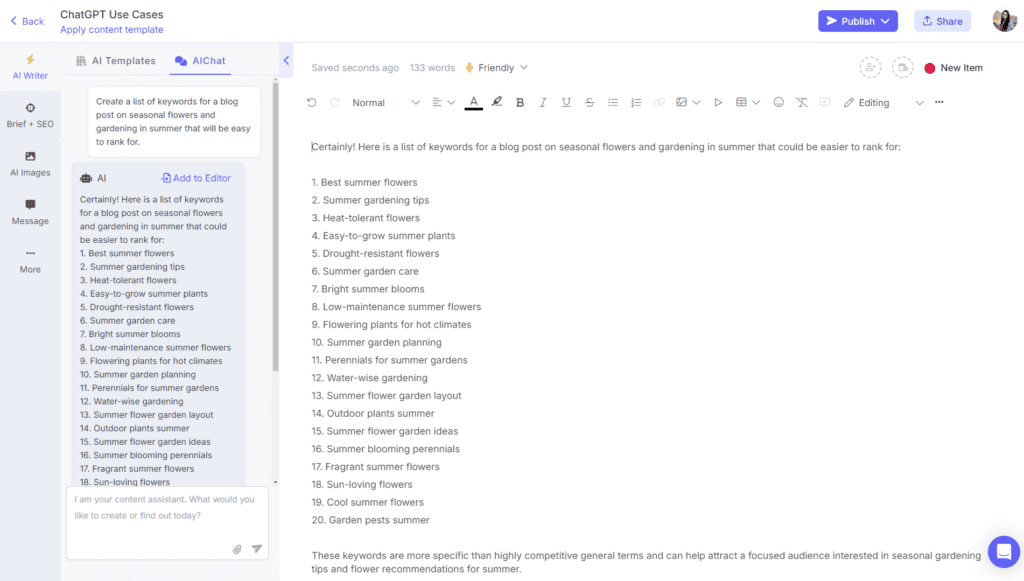
If you need a longer list, you can specify how many keywords you are looking for and the tool will give you that. Make sure to use appropriate and well-crafted ChatGPT prompts for SEO and keyword research, as your prompt determines the quality of the output.
Alternately, you can also use Narrato’s AI Keyword Search tool for your keyword research which gives you keyword ideas along with average search volumes. As for us, we combine these and the keyword suggestions provided by Narrato’s SEO content brief to build a solid keyword strategy.
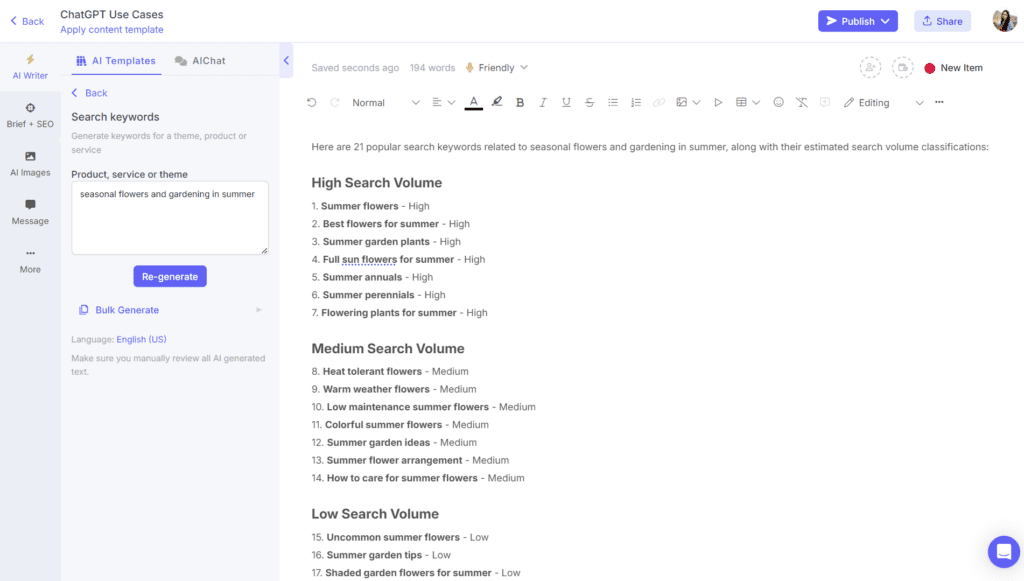
You can also build a comprehensive content brief using ChatGPT.

Topic ideas
After you have picked your primary keyword from the list, you now need an attention-grabbing topic for your blog post. Though we already had a topic idea, we would like to see if ChatGPT can come up with a better topic including the primary keyword ‘Flower gardening in summer’. Before you get started, you might to do some research on the best ChatGPT prompts for blog content writing, ideation, and SEO.
So we asked the tool to give us a list of topics for the blog post.
Use case: Content ideation
Prompt: Suggest 6 blog post topics for the target keyword ‘flower gardening in summer’. Include the primary keyword in the title. Keep the length of the topic to 60 characters.

Based on the keyword we picked, the second topic idea “A Beginner’s Guide to Flower Gardening in Summer” sounds perfect. So we can add that as the title of our blog post.
An alternate tool you can use is Narrato’s AI Topic Generator which also gives you engaging blog topic ideas based on your theme or search term.
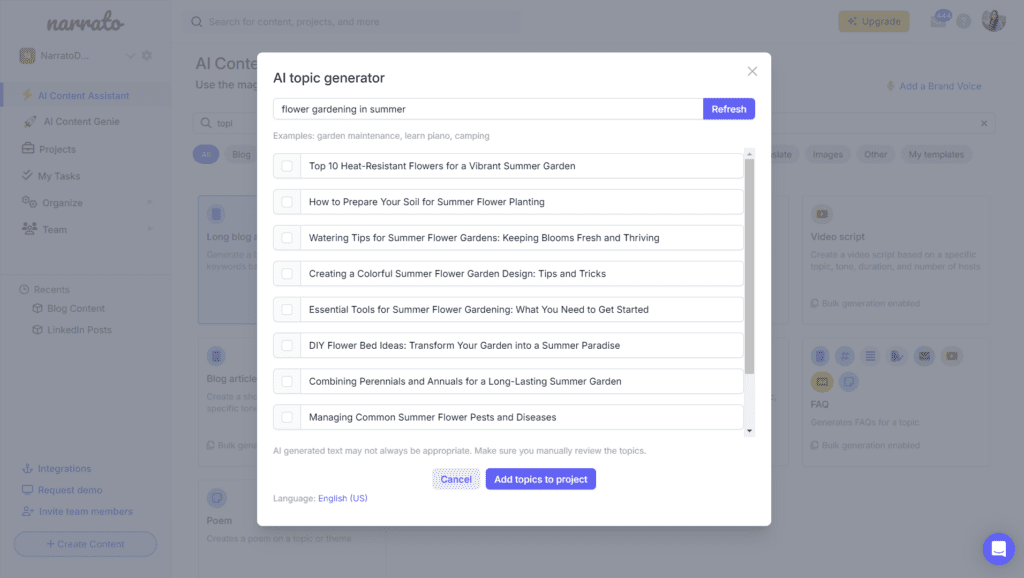
Narrato AI topic generator
Blog outline
The next step in blog content creation is generating an outline based on your research of the top-ranking articles. With creating content with an AI writer like ChatGPT though, you don’t have to go through each and every article to arrive at a solid framework for your blog post.
Just ask the AI writer to create an outline on the topic. If you have any specific requirements, make sure to include them in your query.
For the same blog post that we did keyword research on, we are now generating an outline on Narrato’s ChatGPT tool.
Use case: Blog content outlines
Prompt: Create a blog post outline on the topic ‘A Beginner’s Guide to Flower Gardening in Summer’. The blog post must be unique. Suggest some out-of-the-box tips and ideas.

Look at how ChatGPT generated a detailed outline for our blog post. It even gives you a CTA to add at the end. With this framework to start with, half of the work is already done. This is how an AI blog writer can save you valuable hours in the content creation process.
Or you could use Narrato’s AI Blog Outline Generator to create an outline from just your topic, in your preferred tone or brand voice, no prompt engineering required.
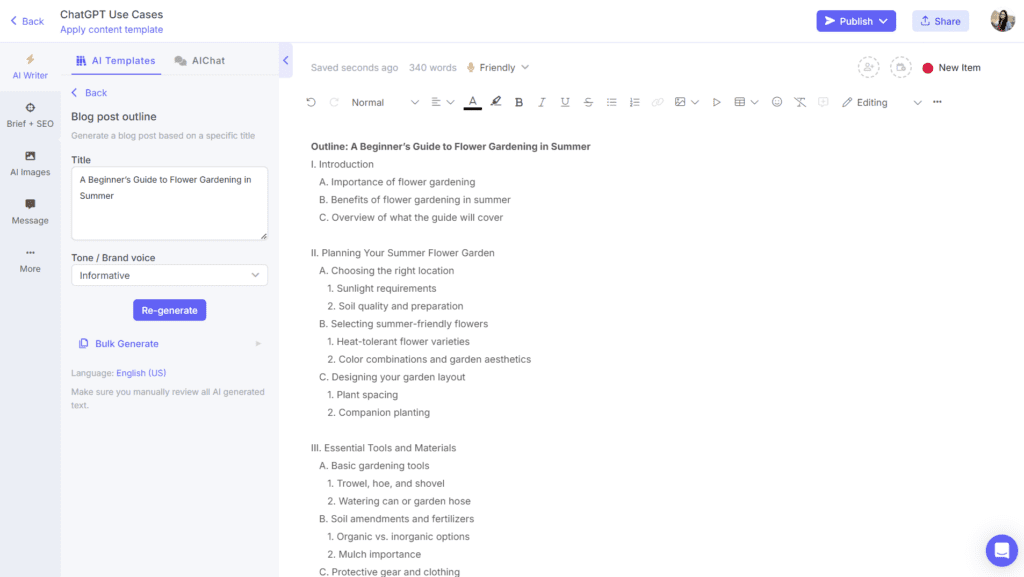
Narrato AI blog post outline generator
Blog post topical research and sectional content
Once your outline is ready, you can start creating content for the blog post. ChatGPT can help in a number of ways with this. From generating intros, paragraphs, or paraphrasing content written by you, it can also help you carry out research for different sections of the blog post. In the above example, say you need research for the section ‘Best flowering plants for summer’. Here’s what we would ask ChatGPT to do.
Use case: Topical research
Prompt: Research the best flowering plants for summer and give a summary in about 200 words. Also, share some links to resources on this topic.
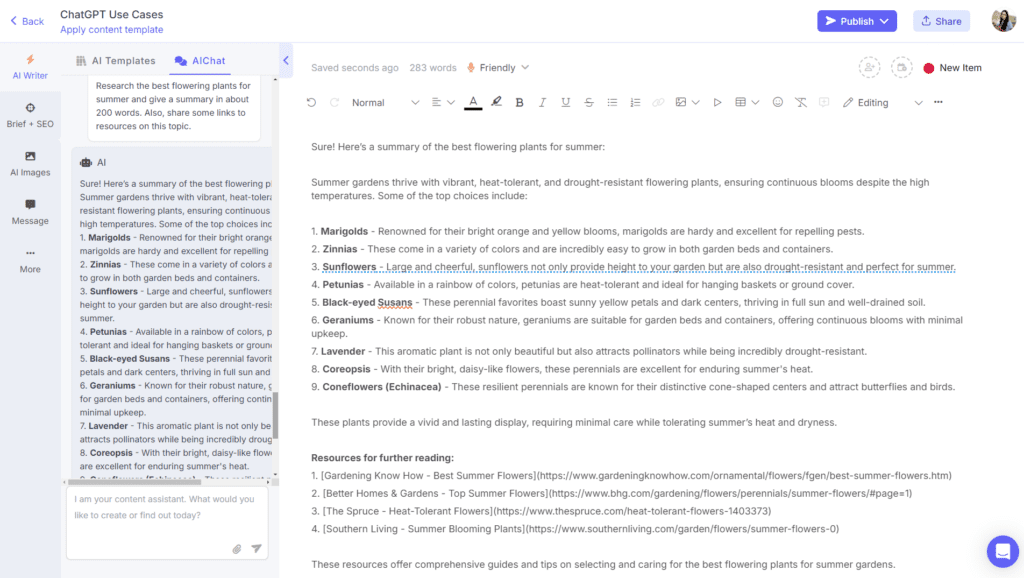
You can see that ChatGPT not only gives you a comprehensive summary of the research but as instructed, it also gives you a list of articles you can refer to for gathering further information. You can go deeper into this research by asking the tool more questions and giving it more context.
Blog post content creation
Instead of getting sectional content from ChatGPT, you could also ask the tool to generate entire blog posts. However, when generating long-form content with ChatGPT, it is important to be extra cautious and ensure that you review the content generated thoroughly. It is also crucial to use the right ChatGPT prompts for writing better and faster.
Here’s an example of a complete blog post generated using the AI Chat on Narrato.
Use case: Blog article writing
Prompt: Write a 500-word detailed guide on the topic “A Beginner’s Guide to Flower Gardening in Summer”, making sure to incorporate [mention key points from the outline].
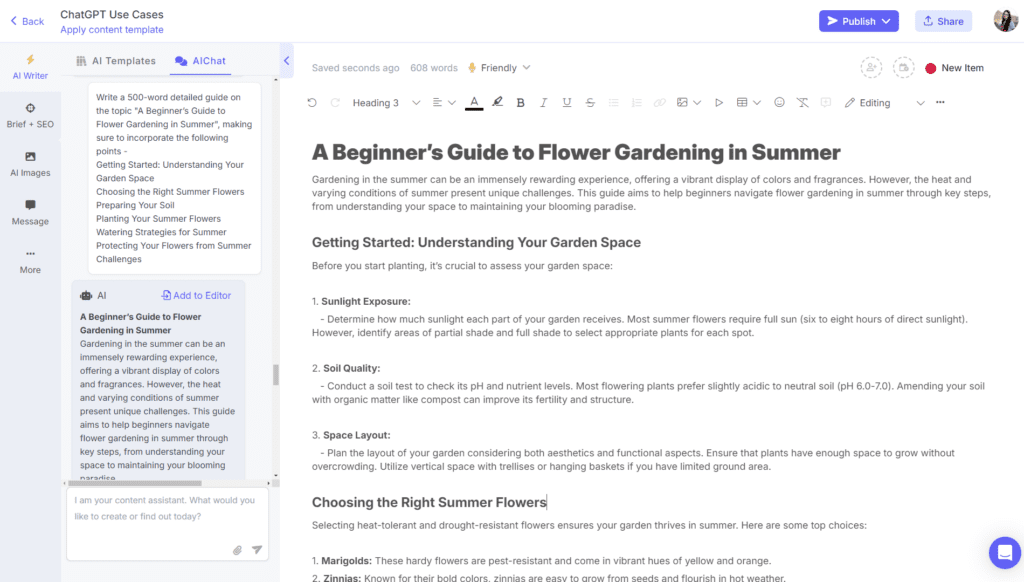
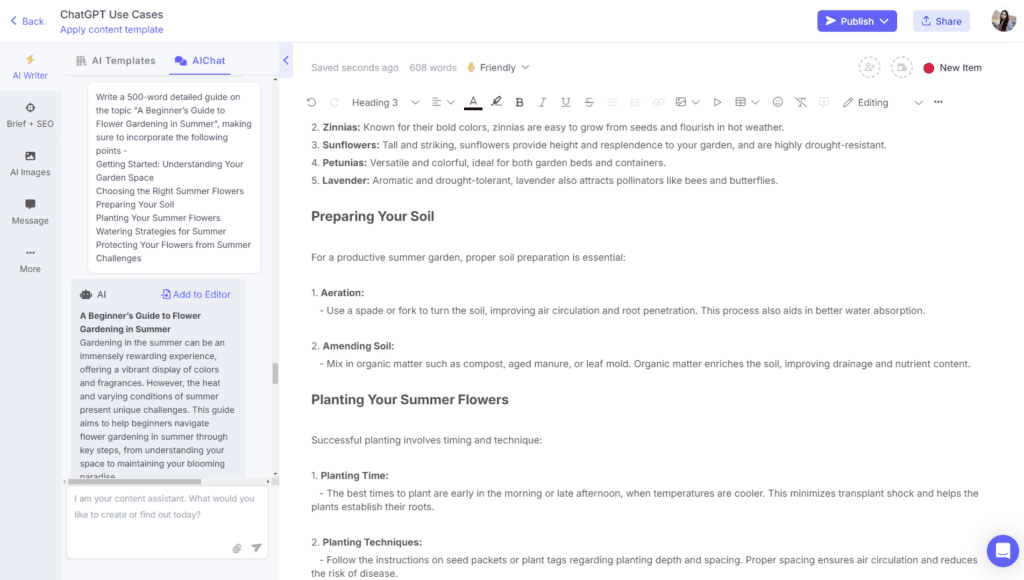
You may also like using Narrato’s AI blog article generator for this, as it lets you generate entire long blog articles from just reference URLs or documents.
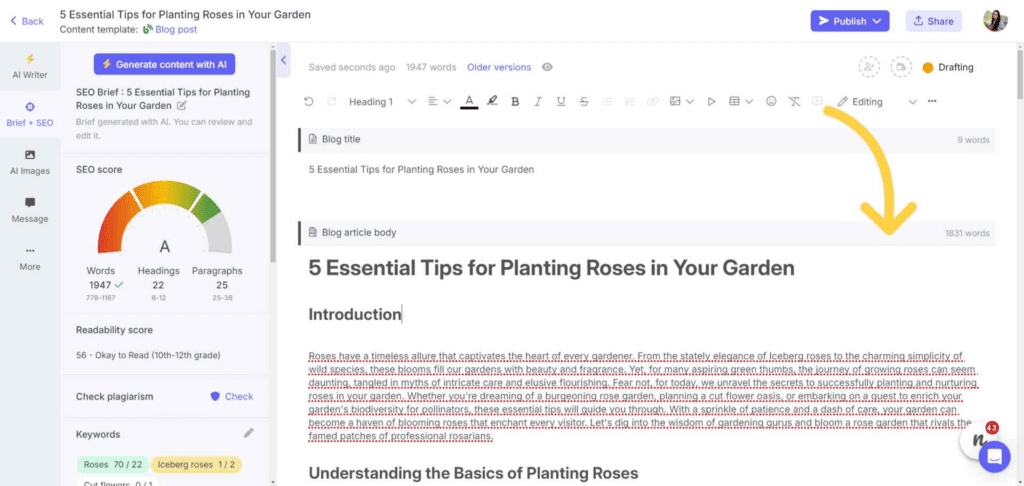
AI-generated long blog article on Narrato
This quick video explains how it works –
Apart from researching and creating content for your blog posts, you can also ask ChatGPT to improve the content you have written. For instance, if you want to change the tone of your original content to make it sound more engaging, or if you want your content to flow better, you just have to explain it in your prompt.
Here’s an example. We asked ChatGPT to improve a paragraph we wrote and write it in the style of famous gardening author Christopher Lloyd.
Use case: Content paraphrasing/ improvement
Prompt: Paraphrase the paragraph below in the style of Christopher Lloyd’s gardening books. Include the keyword ‘gardening in summer’ in your paragraph: <Insert paragraph>
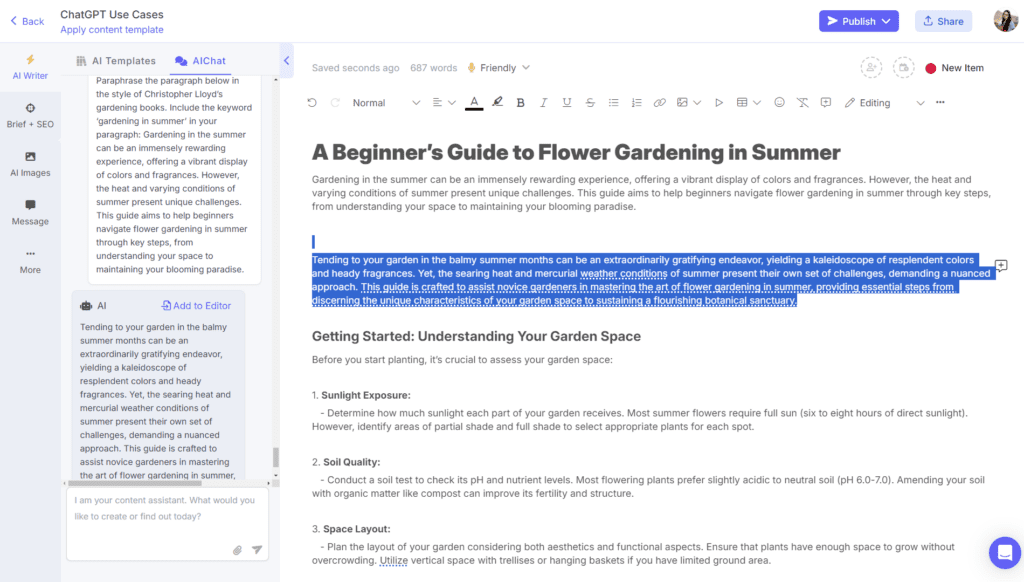
The paraphrased ChatGPT content here is quite satisfactory, except that ChatGPT did not include the keyword we suggested. Though it got the context right. We would probably have to give a second prompt where we ask the AI content writing tool to add the keyword within the paragraph organically. In other words, if the AI-generated content is not perfect or up to your expectations in the first response, you can always improve upon them by giving the tool more and better prompts.
An easier way to paraphrase or rewrite content on Narrato is using our in-line AI writing assistant that use cases like rewrite text, improve text, simplify text and so on. There is also an option “Ask AI” for making custom changes to the content. And if you want to include a keyword in a section, the in-line AI writer can help with that too.
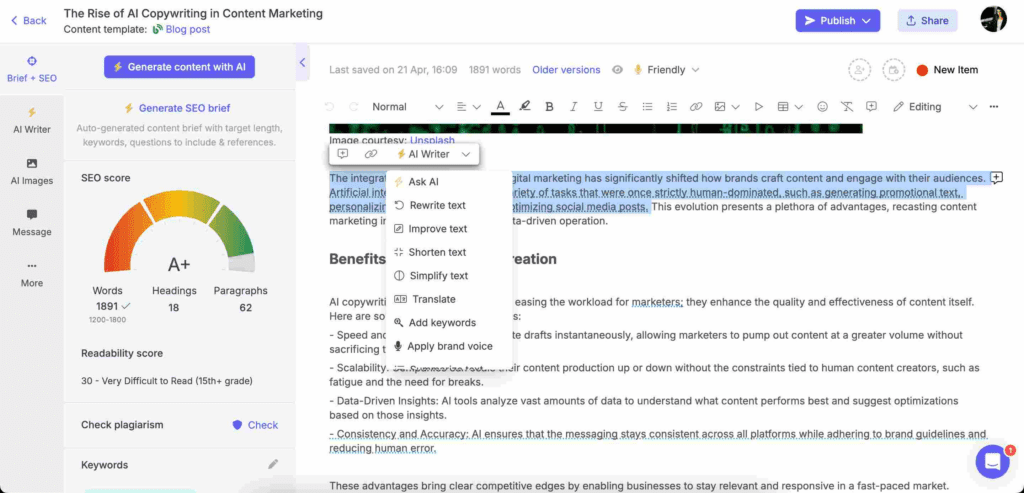
Narrato in-line AI writer

Creating social media content with ChatGPT
One thing that AI writing tools are great at creating is short-form content like social media posts. While ChatGPT can even write a long article for you, it is always best to stick to short-form content and sectional content so that you have more control over what you’re publishing.
ChatGPT can save you tons of effort in creating social media posts. Social media posts are often a rewrite or repurposing of your blogs, articles, or other long-form content. Knowing the right ChatGPT prompts for content repurposing can save you hours of work here. Even when they are not blog promotions, they could be a brief announcement or succinct representation of an idea. Though short, these posts can take a long time to ideate and create. These kinds of repetitive and rule-based content can be simplified through AI content creation.
Let’s create a Twitter thread using ChatGPT to promote one of our blog posts. Here’s the prompt we provided.
Use case: Twitter thread
Prompt: Write a Twitter thread comprising of 5 tweets summarizing this blog post: <link to blog>
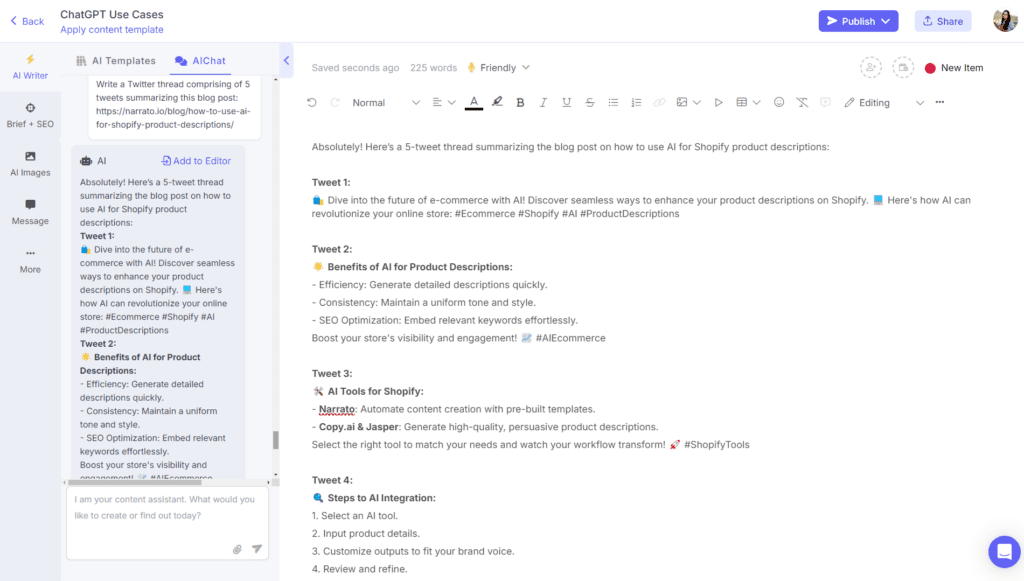
Platforms like Twitter have character limits for a tweet, and ChatGPT makes sure that every tweet in your thread meets that criterion. It also understands other nuances such as using hashtags to make your tweets more easily discoverable.
Alternatively, you can use Narrato’s AI Twitter Post generator for generating Twitter posts and threads.
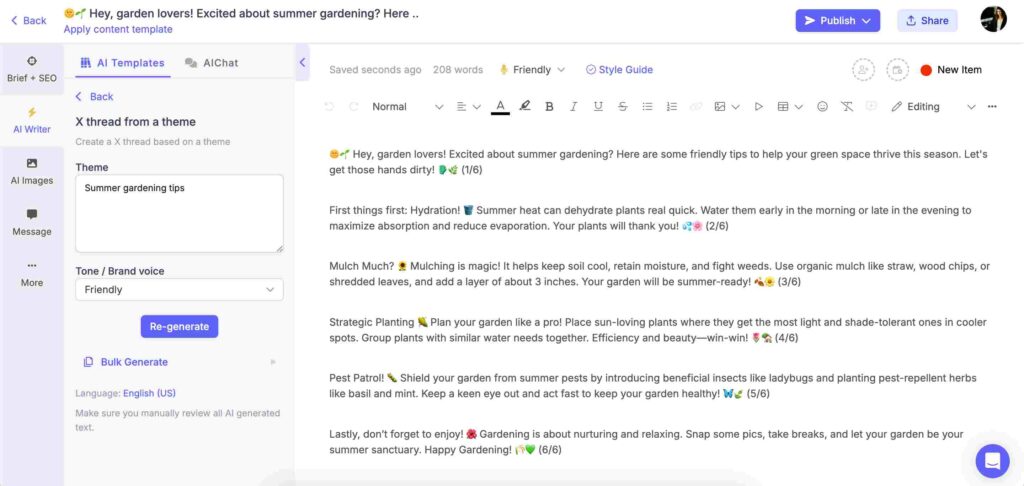
AI Twitter/X thread generator
Let’s generate a social media post for LinkedIn and see what the AI writer gives us.
Use case: LinkedIn post
Prompt: Write a Monday Motivation post for LinkedIn. The target audience is people working in sales and marketing, primarily at a managerial level. Keep the post uplifting and casual.
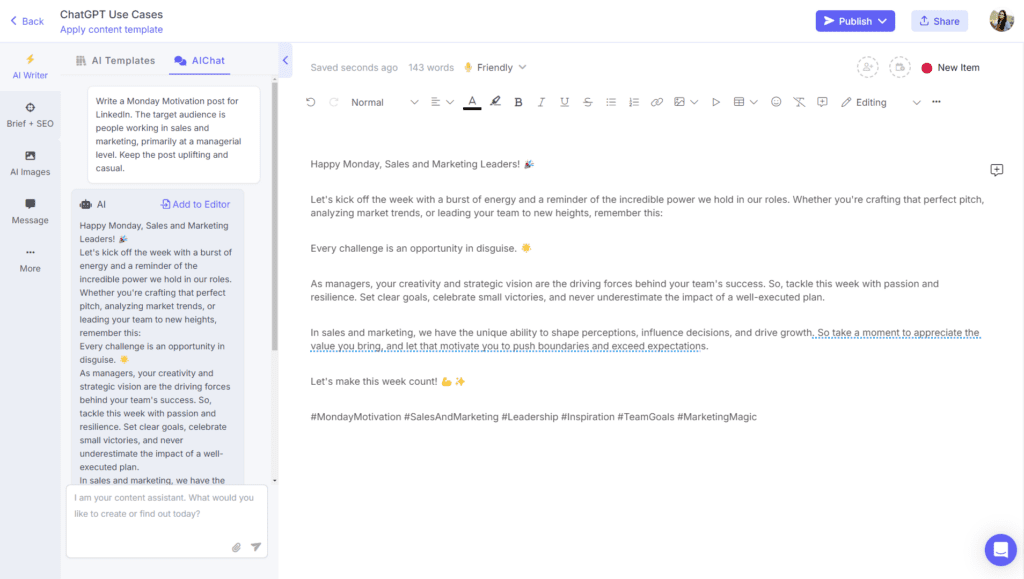
Again it is seen that ChatGPT is aware of the kind of posts each platform encourages. LinkedIn, for instance, is more about longer and well-structured posts, which is what the AI content creation tool gives us. This can be a good head start. If you’d like, you could make slight changes to the post and it would be good to go. To get the best outputs, make sure to use detailed and clear ChatGPT prompts for social media posts. For instance, ChatGPT prompts for Instagram content need to instruct the AI to keep the post short and engaging and use the right hashtags. While ChatGPT prompts for LinkedIn posts can ask for longer, in-depth posts as the platform encourages such formats. Similarly, ChatGPT prompts for Facebook content or Twitter content would require adding the nuances that these platforms demand.
And not just content generation, using ChatGPT prompts for social media managers you can also build your social media strategy, optimize content, and analyze the latest trends effortlessly.
Alternately, you can use Narrato’s AI Social Media Post Generator which has a range of templates for different types of social media posts. You don’t need to add any prompts here. Just fill up the variables like the social media channel you’re creating for, a URL, or some notes from which you want content generated, and that’s it. You can have a post generated in mere seconds.
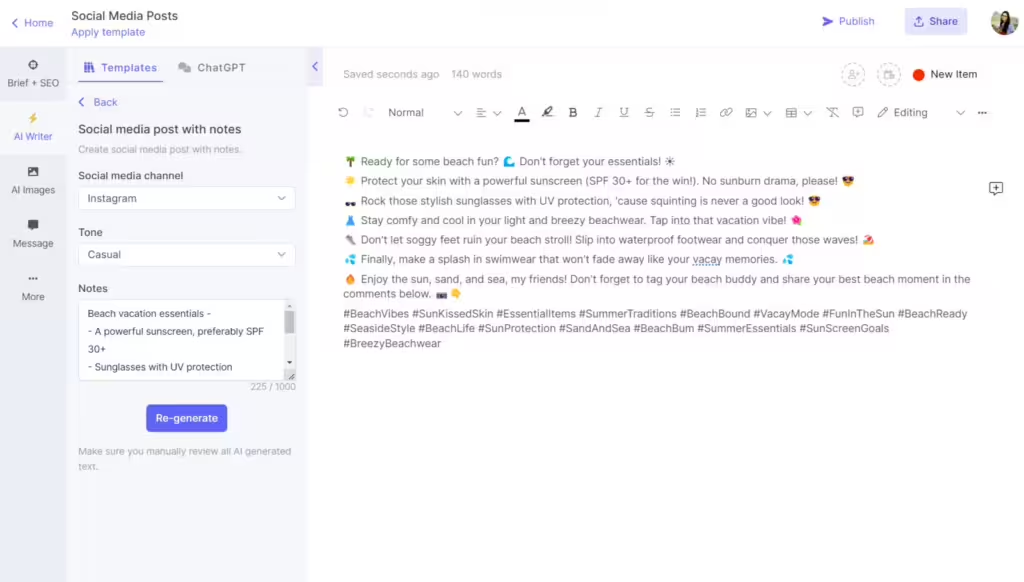
AI social media post generator on Narrato
You can also get an inspirational image to go with it using Narrato’s AI image tool or CC images, since ChatGPT being a language model cannot generate images. With this sorted, you will have a complete post ready within a matter of minutes.
Creating email content with ChatGPT
Another important area of marketing content creation is email writing. Marketing emails are critical in generating leads and building brand name awareness. Most marketing emails and cold outreach emails, however, follow a set format. Your brand may have its own style of drafting emails. And once that is clear, drafting them is just another rule-based activity that you can easily trust AI content creation tools with. In fact, AI writing tools like Narrato’s AI email writer or ChatGPT can create first drafts or emails and catchy subject lines within seconds, making the process much faster and giving us a good base to work upon.
Say you are writing a cold outreach email to prospective clients introducing your product and its features. Here’s how ChatGPT can help with this.
Use case: Cold email
Prompt: Write a cold outreach email for a business.
Name: BAccounted
Service: Business Accounting Service
Key points:
– Professional accounting service for startups.
– Over a decade of experience. Expert advice.
– Affordable monthly packages.
Customers: technology startups that need advice on how to do payroll for small business ventures
CTA: Contact us @ xxxxxxxx
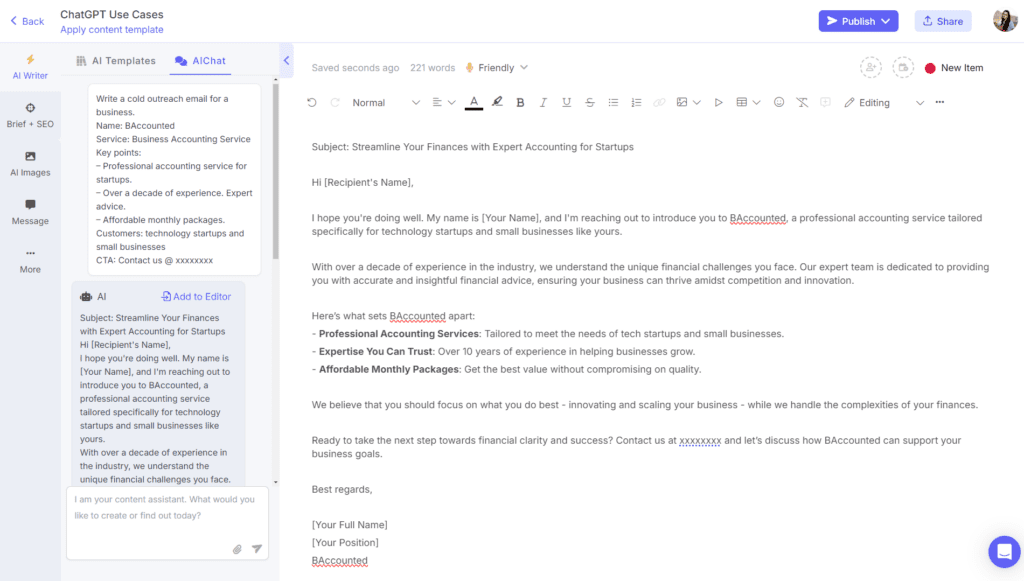
You can even personalize your emails with ChatGPT by providing whatever customer data you have gathered in your prompt. Not just this, you can even create follow-up emails for your cold outreach and marketing emails too.
We generated a follow-up email for the cold email above, and here’s the prompt we used.
Use case: Follow-up email
Prompt: Write a follow-up email for BAccounted checking if the prospective client missed the previous email and may be interested in the product.
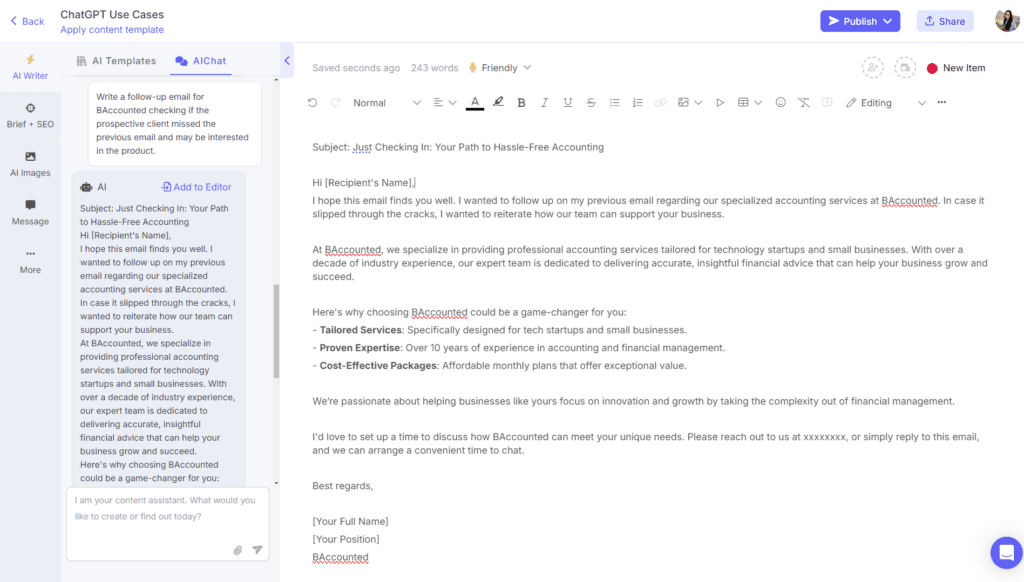
With AI content generation, email marketing will not feel like a task anymore. You can also try generating promotional emails, welcome emails, abandoned cart emails, and more.
Here are a few ChatGPT prompts for email writing and email marketing that could be useful.
1. Sale/Offer promotional email:
Write a catchy subject line and promotional email introducing an offer on the product.
<Product name>
<Product description>
<Sale/Offer>
Provide a CTA to shop now.
2. Customer Feedback/Review email
Write an email seeking customer feedback/ review on our product or service. Start with a note of thanks. Tell them how a review can benefit more people. Share this link directing them to the review page <add link>.
3. Re-targeting/ Re-engagement email
Write a customer re-engagement email. Start by saying ‘We miss you’. Express concern over why they haven’t visited our site in a while. Share the following welcome-back offer and add a CTA:
<Details of offer>
But if prompt writing is not your thing, consider using Narrato’s AI email writer templates for marketing and sales emails that give you great output with minimal effort.
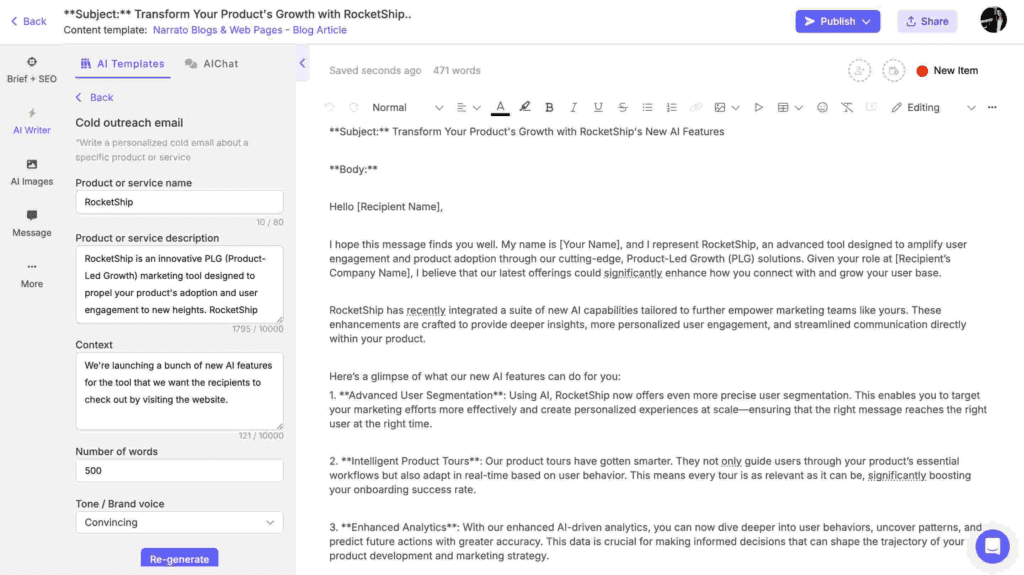
Narrato AI cold outreach email template

Creating web copy with ChatGPT
Web copy is one of the most important marketing content types that you create for a business. It is very important that you take care of key factors like SEO, content structure, and quality even when using AI copywriting tools, be it ChatGPT or others.
Some important elements of good web copywriting are the headlines, product descriptions, key features, and benefits to the user. Website copywriting must be persuasive and convincing, and your prompts to AI content creation tools like ChatGPT must clearly define this.
Website copy
Let’s try generating the headline and an introductory paragraph for a website home page. You can also provide ChatGPT with a system prompt to start with telling the tool what its role should be in this case.
For website copywriting, your system prompt can be this:
‘You are an experienced copywriter with a strong foundation in persuasive writing, SEO, lead generation, and marketing. You are familiar with copywriting frameworks like AIDA, BAB, and PAS, and know how to use them to create compelling copy. You understand consumer psychology and can create content that grabs their attention and drives conversions.’
Once you’ve defined what ChatGPT’s role is, you can go ahead and share your prompt.
Use case: Website copy
Prompt: Write an attention-grabbing headline and a compelling introductory paragraph for a website. Use the following details:
Product name: Healthy Tonic
Product type: Probiotic fizzy drink
Features:
-Refreshing
-Apple, berry, mango flavors
-Brewed with low sugar content
-Good for the gut
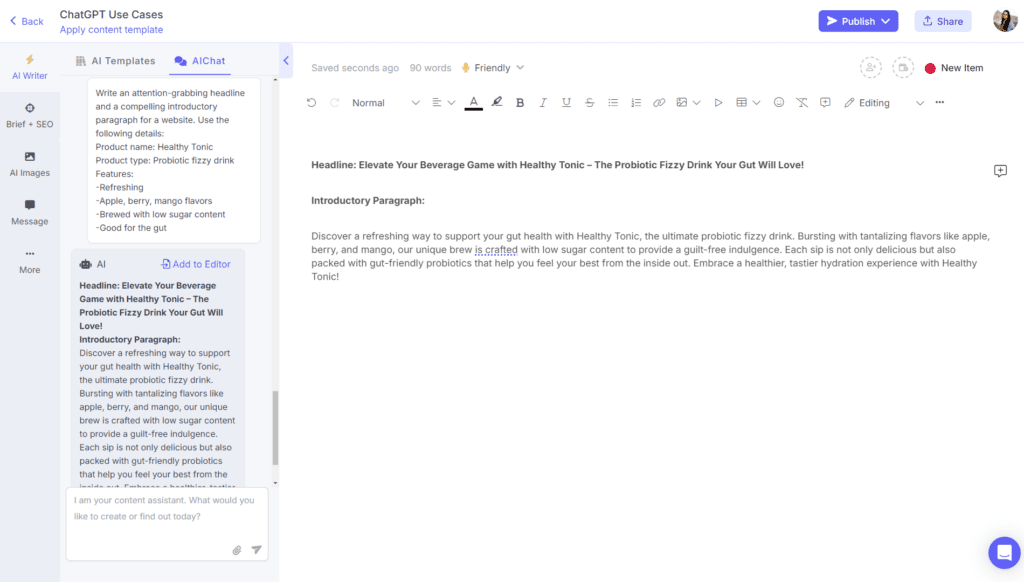
You can further optimize this copy by providing your target keywords and even defining a keyword frequency in your ChatGPT prompts for copywriting and follow-up prompts.
If you want to skip the hassle of prompt engineering, try Narrato’s AI copywriter, which has various AI templates for creating any kind of website copy you need.

AI website copy generator
Product descriptions
You can also create product descriptions for your product landing pages or shopping pages. There are so many different ChatGPT prompts for product descriptions that you can experiment with. Here’s a product description for the above product generated by ChatGPT.
Use case: Product description
Prompt: Create an interesting and persuasive product description for Healthy Tonic. Highlight its health benefits. Provide the key benefits in a bullet list.
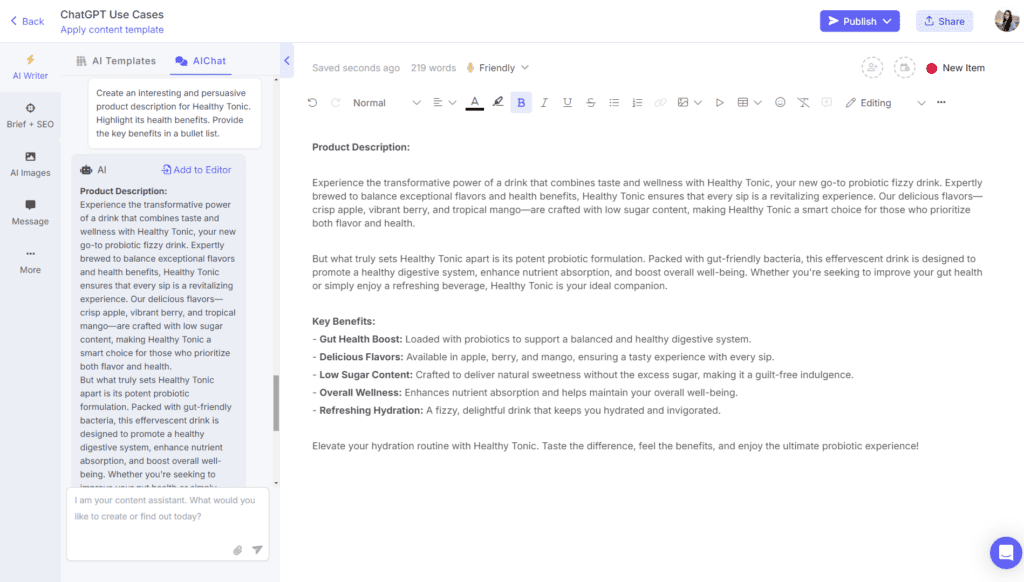
If you’re looking for ChatGPT alternatives for this purpose, try using Narrato’s AI Product Description Generator which gives compelling descriptions from just your product’s brief details. There is an AI Bulk Product Description Generator too, which lets you generate hundreds, even thousands, of descriptions at once.
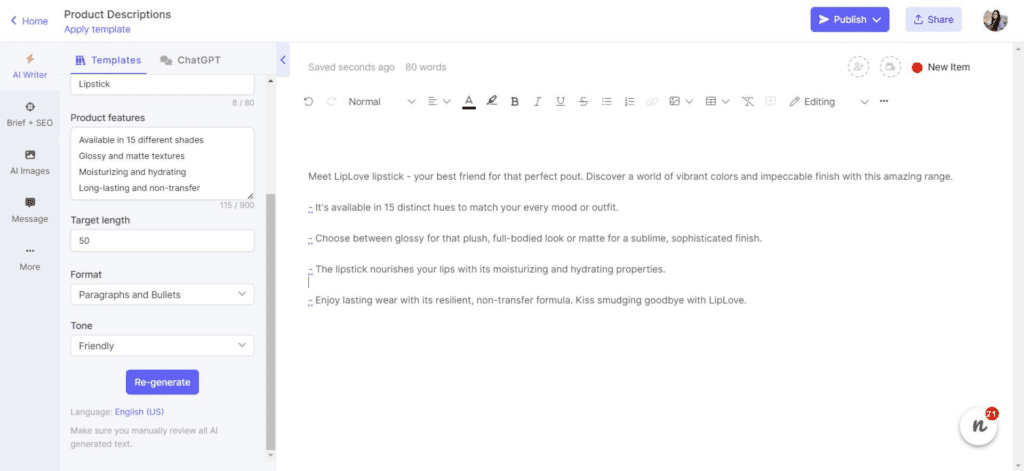
AI product description generator
Here’s a quick video guide explaining how AI product description generator works –
And not just product descriptions, you can also generate property descriptions and other content for real estate marketing with AI tools like Narrato’s AI property description generator or the right ChatGPT prompts for real estate agents.
Ad copy
Ad copywriting requires special skills as you have to convey your message in very words and still make an impact, urging the reader to take action. For a new business or a small content team, it can be challenging as hiring a skilled ad copywriter may not be an option. ChatGPT or AI content assistants like Narrato can be of great help here.
So, let’s say you have to create a print ad for the health drink we’ve used as an example above. With the right ChatGPT prompts for content creation, here’s what ChatGPT can offer.
Use case: Ad copy
Prompt: Create a print ad for Healthy Tonic. Keep it within 50 words. Focus on how the drink is both tasty and healthy. Target audience is health-conscious individuals, mothers, teenagers, and active people.
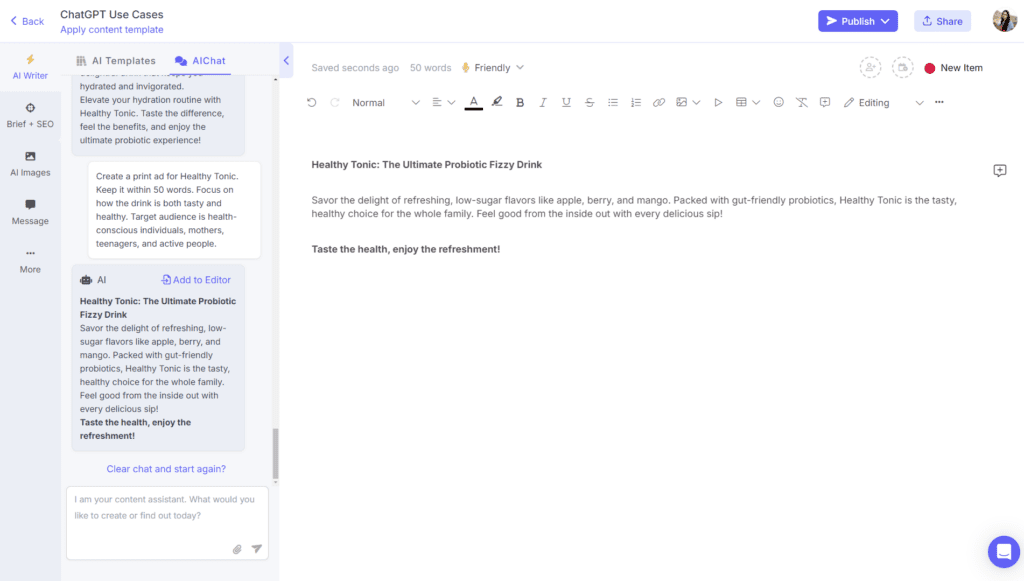
We would probably modify and optimize this ad copy a little bit (especially the part where the AI took the target audience a little too literally!), but nevertheless, it is a good start. We can probably improve our prompt to get a better output here. The key is to keep experimenting until you arrive at what you want.
Alternately, you can also use Narrato’s AI Ad Copy Generator which gives you copy tailored for Google Ads, Facebook & Instagram Ads, LinkedIn Ads, and Classifieds. Here’s an example of copy written by the AI Google Ad Copy Generator on the platform for your reference.
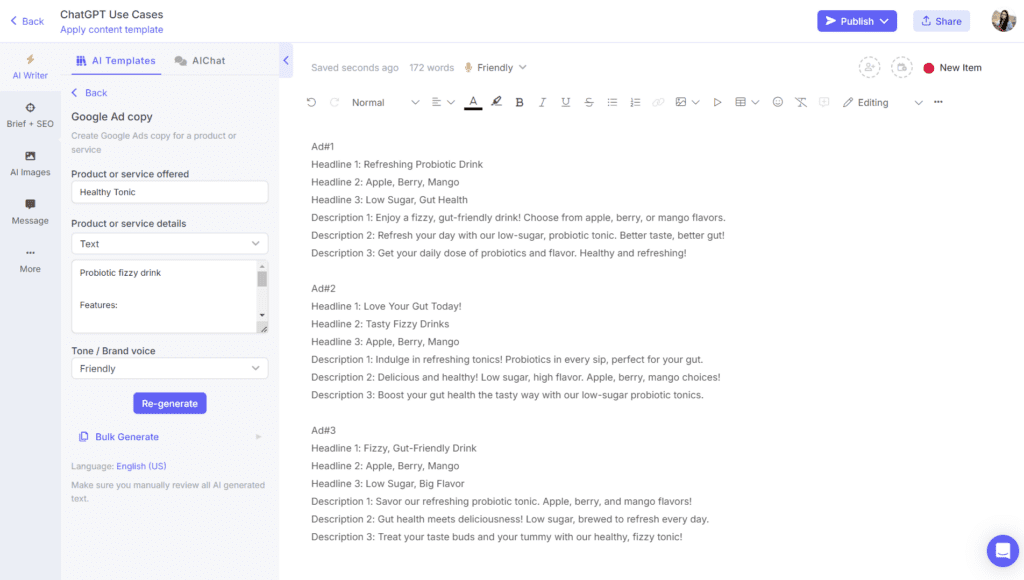
AI ad copy generator on Narrato
As you can see, the copy is customized for Google Ads and the input required is minimal.

Creating SEO content with ChatGPT
We’ve already seen how ChatGPT can help with keyword research. But there are other ways you can use ChatGPT prompts for SEO content creation too. You can use SEO prompts on ChatGPT to optimize your existing content with new keywords. You can also create FAQs on the topic to increase your chances of appearing in Featured Snippets and People Also Ask sections in Google search.
You can generate meta titles and meta descriptions for your blogs and web pages too, on ChatGPT.
Let’s try generating a meta description for the product website we’ve taken as an example above.
Use case: SEO meta description
Prompt: Write a meta description for the Healthy Tonic website home page, within 120 characters. The SEO meta description must contain the keyword ‘probiotic drink’.

You may even ask ChatGPT to restructure and break down your blog posts to improve SEO. For instance, if an existing blog post has too many long paragraphs and sentences, the AI content creation tool can help you break these down to improve readability which in turn affects search performance.
However, Narrato has a tool dedicated to each of these use cases and more. From AI SEO meta description and title generator to the AI Content Improver, all the tools on the platform can play a key role in transforming your content creation process.
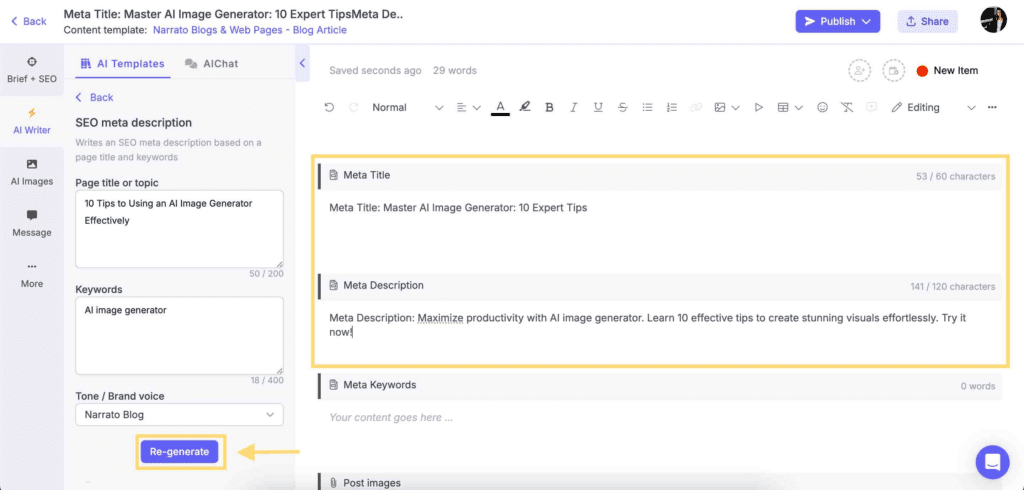
Narrato AI SEO meta description and title generator
Creating content summaries with ChatGPT
A great way to use ChatGPT for AI content creation is by asking it to summarize or explain complex concepts. When writing a thought-leadership article or an in-depth piece, you may come across some elaborate concepts that need a lot of reading to be understood well. But as content marketers, we’re always racing against time. So by using ChatGPT prompts for summary generation, we might actually do better at meeting deadlines.
For instance, let’s say you have a research report with a lot of insightful data and want a summary of what the report says. Here’s how ChatGPT helps.
Use case: Content summarizing
Prompt: Can you summarize this research report and highlight the key points discussed? <link to article>
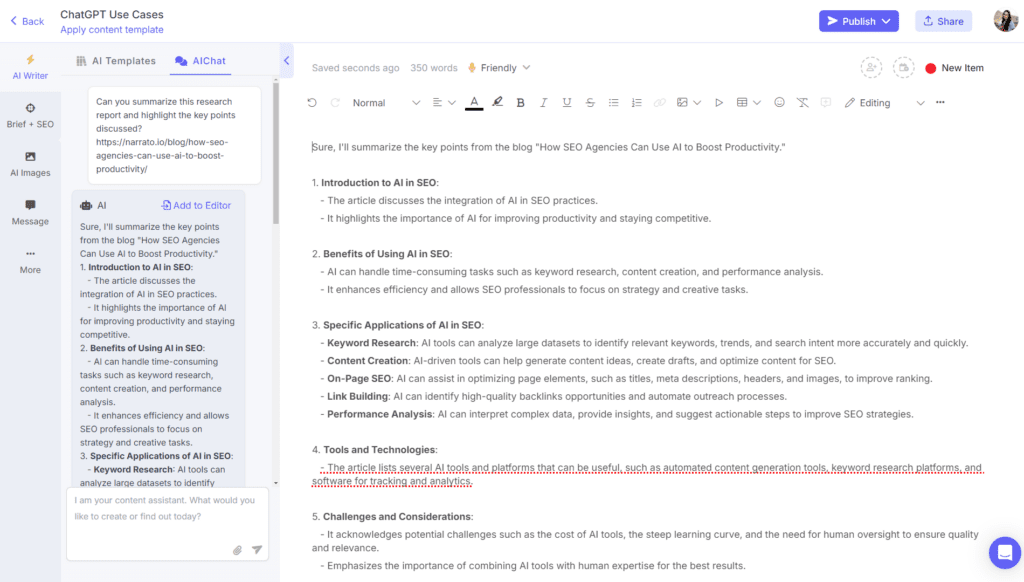
Here you go, several pages of a report condensed into one insightful summary. This use case can also be great for summarizing your own blog posts, articles, white papers, etc. for content distribution on multiple channels. Or you can use Narrato’s AI summary generator for this purpose too. This tool not only summarizes text but also videos, images, and audio content.
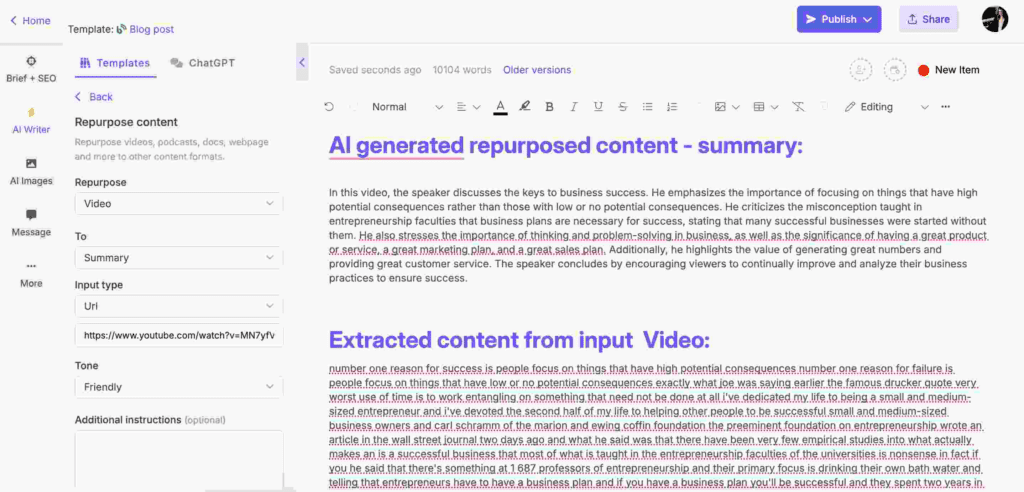
Narrato AI for summary generation
Another good way to use ChatGPT for research and ideation is by asking it to explain concepts. For instance, say you are writing an article on AI image generators and their use, Here’s what we asked ChatGPT.
Use case: Content research/ explanation of concepts
Prompt: How do AI image generators work? (You can try this with any other topic)
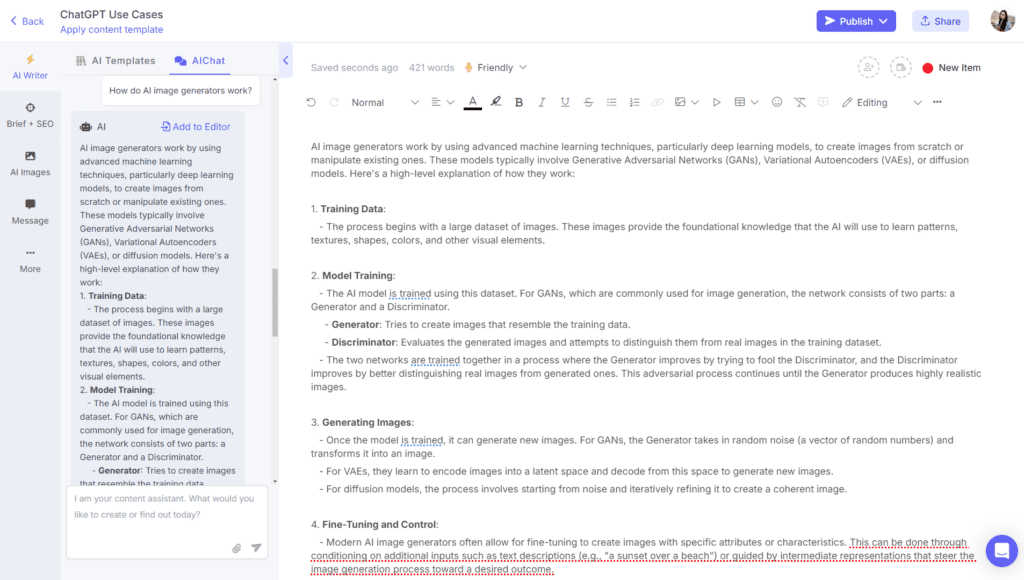
Creating video scripts and descriptions with ChatGPT
If you have built a strong content strategy, then video content is definitely a part of it. Be it videos for YouTube, product tutorials, on-demand webinars, or anything else, video content is a key content type that you must focus on. But video production is effort-intensive, starting from ideation to script writing, to actually recording them, you can end up spending a lot of time and energy in the process.
ChatGPT can help with parts of it, such as writing your video scripts, generating a hook intro, or creating video descriptions for YouTube. Let’s look at an example of ChatGPT prompts for a video content creation and the output it gives.
Use case: Video scripts
Prompt: Create a script for a product launch video:
Product name: Dewy Glow
Product type: Skin cream
Key features:
- Moisturizing and nourishing for the skin
- Leaves a youthful, dewy glow after use
- Prevents skin aging
- Affordable yet effective
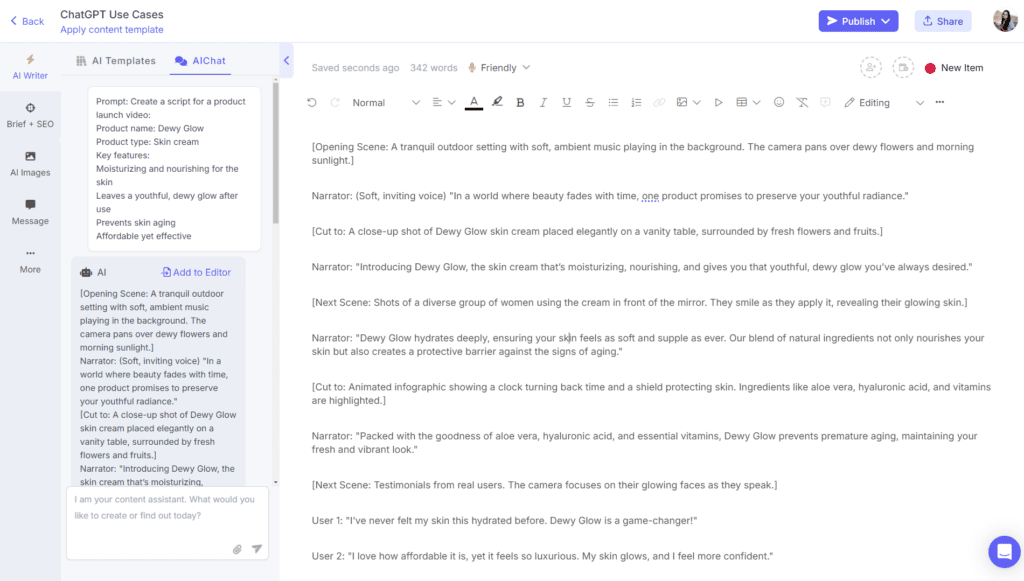

Similarly, you can generate scripts for your webinars, to help you structure your presentation better. You can also generate video descriptions for your existing videos on YouTube as well.
For a faster and simpler content creation experience, you might want to try out Narrato’s AI Video Script Generator and AI Video Description Generator.
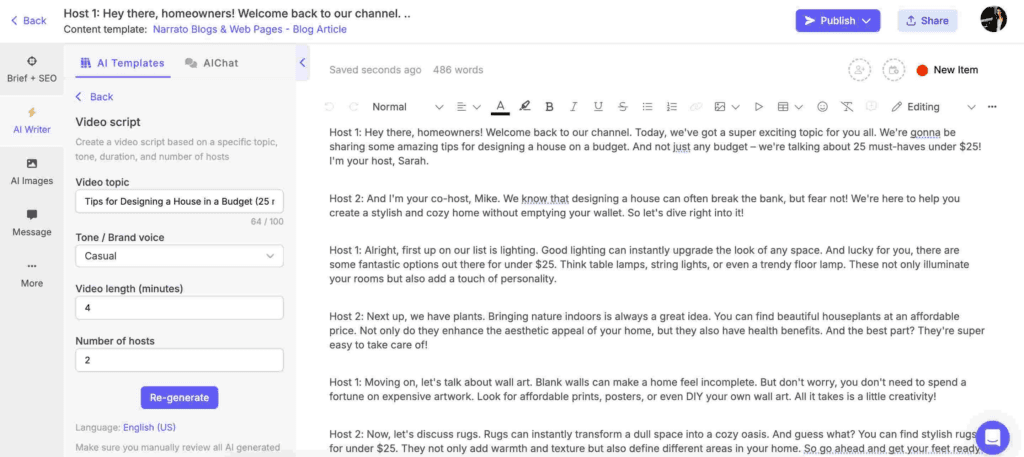
Narrato AI video script generator
Creating press releases with ChatGPT
ChatGPT and other AI content generation tools can be great for writing press releases as they are mostly matter-of-fact and straightforward. You could give the key points for your press release or news article in your prompt. If it’s a fairly recent event, however, make sure to provide enough context to the AI writer as it may not have access to the information online.
We tried generating a press release article on the launch of the latest iPhone to see what the language model can deliver.
Use case: PR/News article
Prompt: Write a concise but informative press release article for the launch of the latest iPhone by Apple.
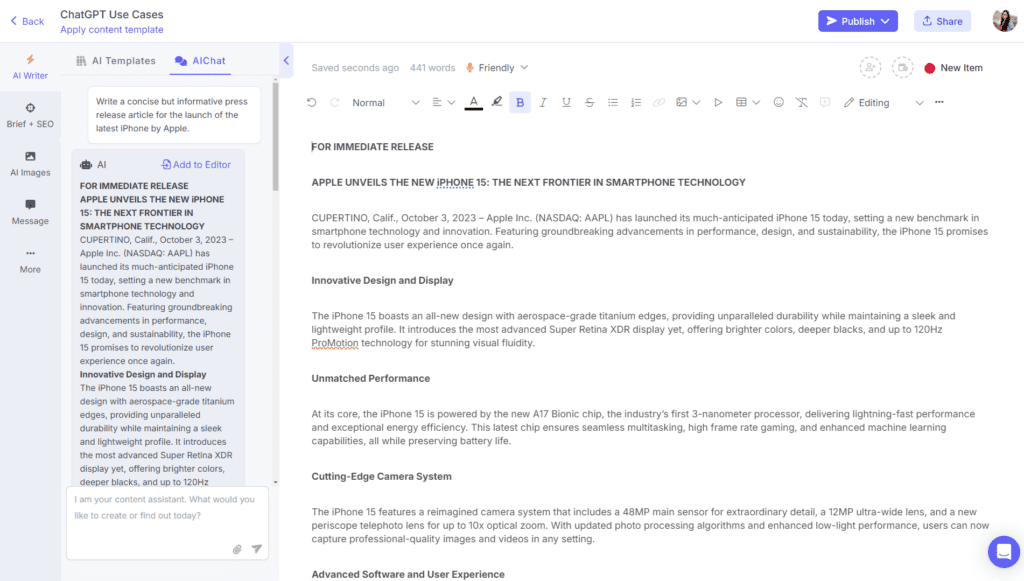
Now, you might say that Apple’s iPhone is a well-known product, no wonder ChatGPT can write a news article on it. But what about a PR article for your lesser-known or new brand? Well, we tried that too and the results were quite impressive.
Use case: News article
Prompt: Write a press release about:
Company: Bella
Product: Women’s dresses and accessories
Announcement:
- Launch of spring collection 2023
- Lemon yellow and peach main colors
- floral designs
- comfortable, flowing fits

Narrato AI press release generator makes this much easier.

Narrato AI press release generator

Collecting statistics and figures with ChatGPT
Whether you are compiling a post on statistics or simply looking for some solid figures to add to your content to increase credibility, finding the appropriate statistics is always time-consuming. ChatGPT can help by compiling a list of statistics and figures for you. All you need to do is provide the topic around which you’re looking for stats. Also, remember to ask for the source links in your prompt as it is necessary to cite the original source.
Here’s an example.
Use case: Facts and figures
Prompt: Give me a list of statistics and facts on ‘AI content creation’. Also share the links to the sources.
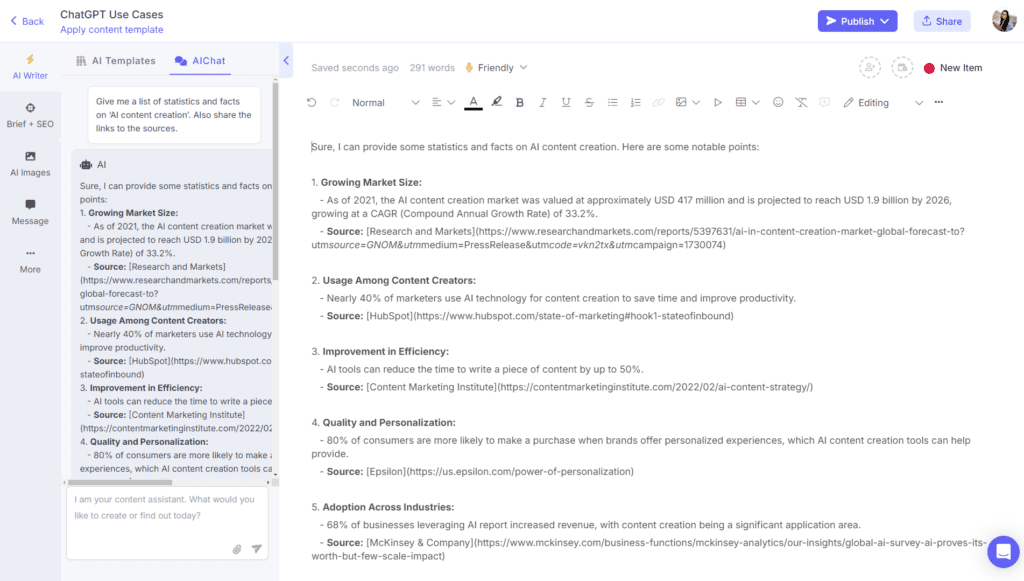
So here’s about an hour of searching cut down to under a minute. You can also define in your prompt how many statistics you want the tool to collect, in case you want a longer list.
Editing and content quality assessment with ChatGPT
ChatGPT can also help you with editing and refining your content after you are done writing. It can help you proofread and detect any errors, such as grammar mistakes, spelling mistakes, or typos. It can also help clean up your content and make it more engaging by removing unnecessary fluff and redundant words.
Here’s a prompt you can try.
Use case: Content proofreading and editing
Prompt: Can you help proofread the content below? Check for any grammatical errors, spelling mistakes, and punctuation errors. Also, check for redundant words and sentences and rephrase accordingly: <Excerpt from blog post>
Translating content into different languages with ChatGPT
If your business needs to target different markets and optimize its content for a local audience, ChatGPT can prove to be a very handy tool. Here’s an example of ChatGPT’s translation capabilities.
Use case: Language translation
Prompt: Translate the following paragraph to [your preferred language]: <share the content to be translated>
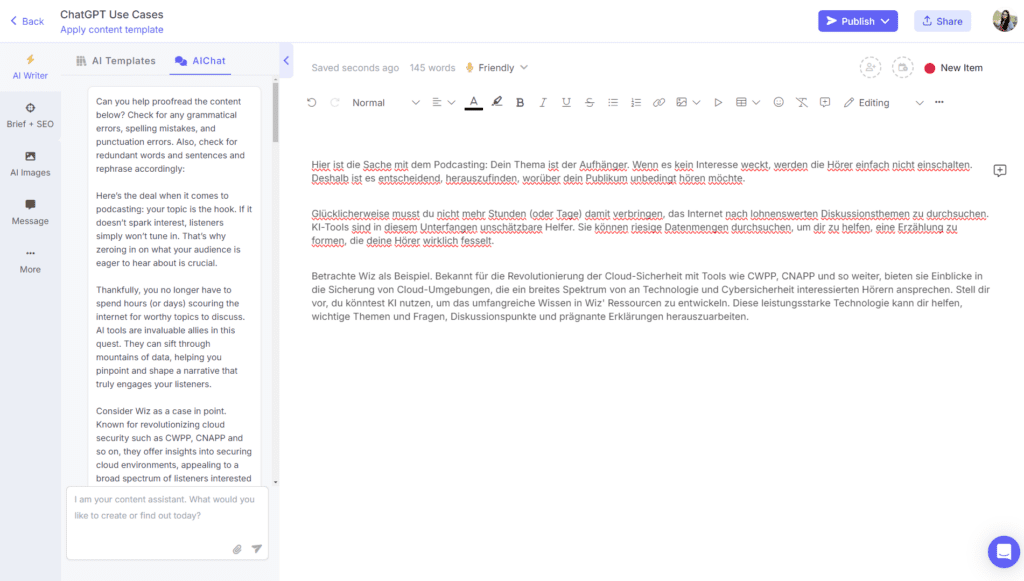
It is important to verify, though, that the translated content is correct and conveys the message appropriately. Sometimes, meanings and contexts may change during translation, so you have to be extra cautious when using AI tools in this regard.
A ChatGPT alternative you can use here is Narrato’s AI translation tool.
Does ChatGPT also generate images?
While the makers did integrate image generation capabilities into ChatGPT later on, it isn’t the best choice for this purpose. Apparently, many users have faced issues when trying to generate images and ChatGPT wasn’t able to give an output. Instead, you can use a tool like OpenAI’s Dall-E or Narrato’s AI Image Generator.
Just use some creative AI image generation prompts and watch the AI work its magic to give you images in a variety of styles.
Apart from ChatGPT prompts for marketing success, you can also use ChatGPT prompts to create sales content. No matter what you are using the tool for, some best practices can help you achieve better results. We’ll discuss them in the following section.
Tips and tricks for using ChatGPT effectively
ChatGPT is a very powerful AI content generator tool, but it is also a little tricky if you really want high-quality content. Simple queries are fine as long as you need simple answers or are only trying to learn something new. But when it comes to using the tool for content creation, you have to ensure that you are providing it with enough material and context to give you a ready-to-use output.
Here are some best practices you must adopt when using ChatGPT for content creation.
1. Experiment and fine-tune ChatGPT prompts for better output
The prompts you provide are a deciding factor in what the output quality will be like. The more detailed, easily comprehensible, and contextual your prompts are the better the tool will be able to generate high-quality content that meets your needs. Your prompts don’t always have to be lengthy, but they must contain all the information you want capture in the AI-generated content.
For instance, a good prompt for a Call to Action can be this:
Generate 5 strong calls to action to “buy modular furniture” targeted towards “millennials”
This prompt defines what the product is, what action you want the audience to take, and who the target audience is.
A bad prompt, in this case, would be:
Create a CTA for a furniture seller
This prompt does not define what kind of furniture you’re selling, which makes it hard to create a targeted CTA. It also does not define who the CTA is directed to and what you want them to do.
Let’s take another example. Say you’re trying to build an advertising campaign and want ChatGPT to provide you with a framework.
Good prompt:
Create an advertising campaign for a “new energy drink” targeting “18-30-year-old young adults”. Choose a target audience, develop key messages and slogans, select the media channels for promotion, and decide on any additional activities needed to reach your goals.
Bad prompt:
Create an advertising campaign for a new energy drink. Provide a complete outline.
Though ChatGPT will give you outputs for both prompts, the one that you get with the first prompt will be far more comprehensive as you have clearly stated what you are looking for. The second prompt will give you a more generic output.
2. Use follow-up prompts to improve the responses
Always use follow-up prompts and give the tool additional information if you want a better response. The more questions you ask or prompts you provide, the more you are training the AI copywriting tool to understand your preferences and style.
3. Use prompts like ‘in the style of’ to train ChatGPT on your preferred writing style
If you follow some famous writer or popular publication in your writing style, using ‘in the style’ of can help ChatGPT generate a more apt response. We’ve already shown this in our example of content paraphrasing, where we ask the tool to write in the style of famous gardening author Christopher Lloyd. You could also ask ChatGPT to write in the style of a New York Times article or a Vogue cover story, for instance.
4. Give ChatGPT a word count, especially if you want longer responses
ChatGPT responses are usually not very long. Unless you provide a word or character count, the tool will generate responses of standard length. If you want a longer list or a long-form piece of content from the AI tool, define the numbers you’re looking for.
5. Organize your chat in threads
ChatGPT lets you interact in chat in a thread format. It is best to keep your chats organized in these threads. This not only makes it easier for you to find the content later when you need it but also gives the AI more context when you ask follow-up questions.
6. Understand the tool’s limitations
Like all AI tools, ChatGPT also has its limitations. Currently, it is only trained on data up to a certain point in time. Though this data will expand over the years, it is still not possible for an AI tool to present any original ideas and it can only give you what it has learned from training data. So using AI writing tools to create original content for thought-leadership or opinion pieces may not be a good idea. Understand what the tool is capable of and use it to its best capacity in those areas. It is also essential to prioritize ChatGPT security to safeguard sensitive customer data and prevent potential vulnerabilities or other regulatory compliance issues.
7. Verify all AI-generated content, facts, and figures
Lastly, ensure that you proofread and verify all AI-generated content. There may be inaccuracies and errors if the data they are trained on is faulty. There may also be some built-in biases in ChatGPT and other tools, owing to biases they come across in their training data. So human intervention and review are extremely important when using AI writing and content optimization tools.
Once you have a list of solid prompts that you use frequently, you can create custom AI templates on Narrato and convert ChatGPT prompts to AI templates that are ready-to-use and help generate content much faster.
Now that you have a good idea of how to use ChatGPT for content creation, we hope you will be saving hundreds of hours in your content creation process. Remember though, that AI tools are built to assist human writers and not overshadow their creativity. Use tools like Narrato and ChatGPT in conjunction with your excellent content creation skills, and you’re sure to see some amazing results.


